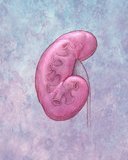Description of the disease pyelonephritis, treatment

Description of the disease pyelonephritis, the treatment of which is a rather complicated process, you should start with the question of what is pyelonephritis?
Pyelonephritis is a kidney disease in which there is inflammation of the renal pelvis, parenchyma, calyces or the intermediate tissue of the kidney. The disease has a predominantly bacterial etiology.
Puncture and excision biopsy of kidney tissues revealed that pyelonephritis can occur in three forms:
- Chronic with exacerbation;
- Chronic;
- Acute;
Pyelonephritis has no age restriction or sexual predisposition. Any person can undergo this disease. However, physicians still identified several groups of people who are most at risk of pyelonephritis. To such risk groups are:
- Preschool children( up to 7 children) who have anatomical features of the body structure or development.
- Women aged 18-30 years - pyelonephritis they can develop as a result of the onset of sexual activity or in consequence of pregnancy or childbirth.
- Men after 45, suffering from prostate adenoma.
- People with urolithiasis or frequent attacks of renal colic.
All these diseases violate the outflow of urine, and urine stagnant in the body is an excellent medium for the propagation of bacteria of pyelonephritis.
There are several other factors that can affect the development of pyelonephritis:
- Diabetes mellitus;
- Chronic inflammation;
- Decreased overall immunity.
And although these factors affect the development of the disease to a lesser extent, but still they have a place to be.
The most common pathogens provoking the development of the disease are:
- Staphylococcus aureus;
- Proteus;
- E. coli;
- Pseudomonas aeruginosa;
- Enterococcus.
Symptoms of pyelonephritis
Pyelonephritis usually begins suddenly and manifests an instant rise in temperature to 39 ° C or more. Simultaneously with fever, symptoms such as headache, weakness, increased sweating, sometimes the patient begins to vomit and vomit, the lower back begins to ache. Pains are usually blunt with varying intensity. In the development of pyelonephritis in a person with urolithiasis, attacks of renal colic begin. If the disease is not complicated by anything, then a violation of urination may not be observed. In general, the symptoms of pilonephritis are very similar to the symptoms of influenza, ARI and ARVI, and therefore require additional diagnosis of the patient to establish the true causes of their causes.
If the treatment of the disease is not started in time, then the development of suppuration can begin, and the disease itself can go into a chronic form, burdened with complications. Suppuration of the kidney tissue can occur as:
- Abscess;
- Carbuncle;
The appearance of suppuration can be assumed from body temperature jumps, they range from normal 36 ° C in the morning to 40 ° C in the evening.
The chronic form of pyelonephritis occurs mainly with untreated acute pyelonephritis and very rarely occurs on its own. Sharpening, chronic pyelonephritis presents the patient all the delights of the acute form of the disease. The chronic form of the disease is treated much longer and more difficult.
To accurately diagnose and determine the complexity of its shape and intensity of flow, the physician should prescribe the following tests:
- Urine - general and bacteriological and Gram staining;
- Blood - general and biochemistry;
- Conduct ultrasound and x-ray studies of the urinary tract.
Pylonephritis: treatment with
Uncomplicated pyelonephritis is treated with conservative methods, including:
- Antibiotic therapy - aminoglucosoids in combination with penicillin;
- Anti-inflammatory therapy;
- Infusion-detoxification therapy;
- Physiotherapy;
- Desaggregants and anticoagulants.
be obtained urine culture, assigned empirical antibiotic therapy fluoroquinoline. After the result of urine is received, the appointed therapy is subject to correction.
To improve the efficiency of treatment, the doctor may prescribe antibiotics Intra, t. E. The antibiotic is injected under pressure into a special catheter into different pressure chambers. The procedure can be repeated 4-5 times.
One two times a week the patient is given a functional-passive kidney massage with 20 ml of lysicle.
If a patient is diagnosed obstructive pyelonephritis form, requires the fastest possible recovery of urinary outflow, it uses perktuannaya, nephrostomy puncture, after which the infusion is assigned and antibacterial therapy. In some cases, it may be administered catheterization mochetoka in the affected side
parallel with medicines is advisable to use various antioxidants, which include:
- vitamin A or retinol,
- vitamin C or ascorbic acid,
- vitamin E( tocopherol),
- β - carotene,
- ubiquinoneor coenzyme Q10,
- selenium and m. p.
Research in this area has shown that included in the total antioxidant therapy, administering to the patient at a time when the disease begins to subside, increases the activity of ferENTOV inside the cell, enhancing and accelerating the regeneration of cells, leading to early recovery.
In cases where conservative methods are not sufficient to eliminate the problem of pyelonephritis, surgical intervention is necessary. This form of treatment has two types: organo-carrying and organ-preserving. Comment on the first form does not make much sense because its name speaks for itself. This type of intervention is carried out as a last resort, when the treatment is no longer possible and the patient can save only the removal of the organ.
The volume of the organ-preserving surgical intervention is entirely determined by changes in the kidney. The kidney afflicted with pyelonephritis is subject to decapsulation in any manifestation of purulent pyelonephritis.



